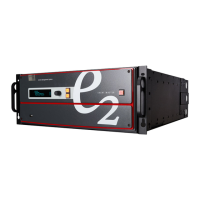5. Front Panel Menu orientation
5.3 Using menu system
General
This section describes the conventions for using the E2’s menu system. For reference, the following illustration shows the System
Menu.
Image 5-3
System menu
The E2’s display screen is four lines high. Throughout this chapter, entire menus a re shown for ease of ref-
erence, unless otherwise noted.
Please note the following important m enu rules and conventions:
• The top line names the current m enu, in upper-case letters.
• Subsequent lines typically display two fields:
-Forafunction, t he left-hand field names the function. The right-hand field shows the function’s current param eter (or value).
In the preceding illustration, Black Invalid is a function and On is its current value.
-Forasubmen u, the left-hand field names the s ubmenu that y ou can access. The right-hand field displays a double arrow
(>>), indicating that a s ubmenu is available. In the preceding illustration, USB Backup/Restore and Ethernet are two of
the available submenu s. To use a submenu, scroll to it and press SEL. Then scroll through the list that appears.
-Thenavigation cursor (>) in the left-hand column indicates the c urrent line on which you can take action. This arrow moves
as you rotate the ADJUST k nob on the front panel. When you reach an editable field and press SEL, the navigation cursor
changes to an edit cursor (#).
Making a menu selection
To s elect a men u item, use the ADJUST knob to s croll to the item, then press the SEL button on the front panel:
• To scroll through a menu:
- Turn the ADJUST knob counter-clockwise to s croll down.
- Turn the ADJUS T knob clockwise to scroll up.
• To open a submenu, scroll to the submenu line and press SEL.
• To change a parameter, scroll to the desired line and press SEL. The navigation cursor changes to the edit cursor. Use the
ADJUST k nob to m odify the value:
- Turn the ADJUST knob clockwise to increase a value.
- Turn the ADJUST knob counter-clockwise to decrease a value.
• Then pre ss SEL to ac cept a parameter or v alue. T he edit c ursor changes bac k to the navigation cursor.
You must press S EL to accep t the value.
Throughout this user ’s guide, the term “select” is used as an abbreviation for “scroll to a menu line and press
SEL.”
Example: Select the Ethernet menu to beg in configur
ing network settings.
Exiting a menu
• In the edit mode (i.e., the edit cursor is visible), pre ss ESC to exit a menu without changing the original parameter.
• To nav igate back up the menu structure, press ESC again. E ach press takes you back up th e m enu tree by one level.
48
R5905948 E2 12/12/2014

